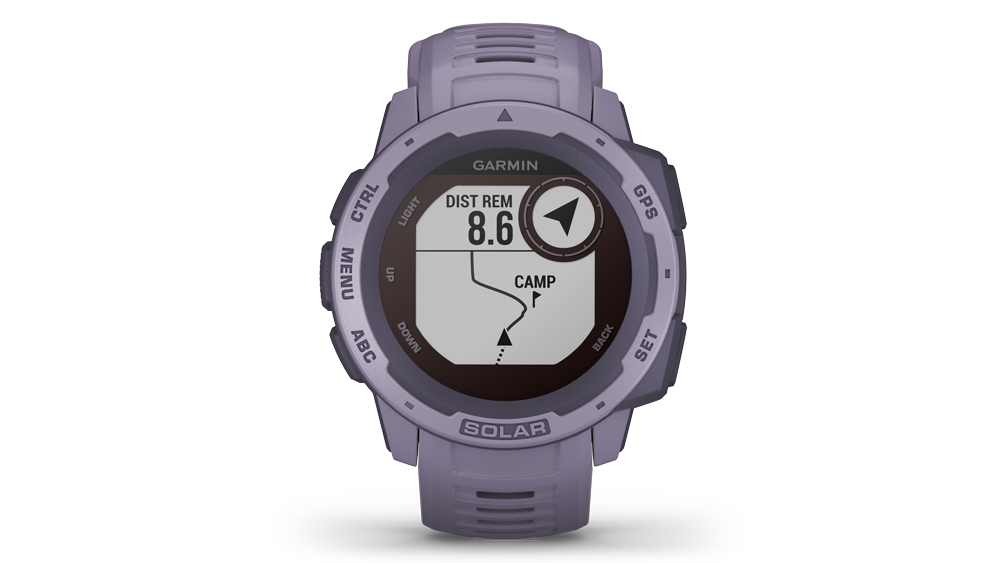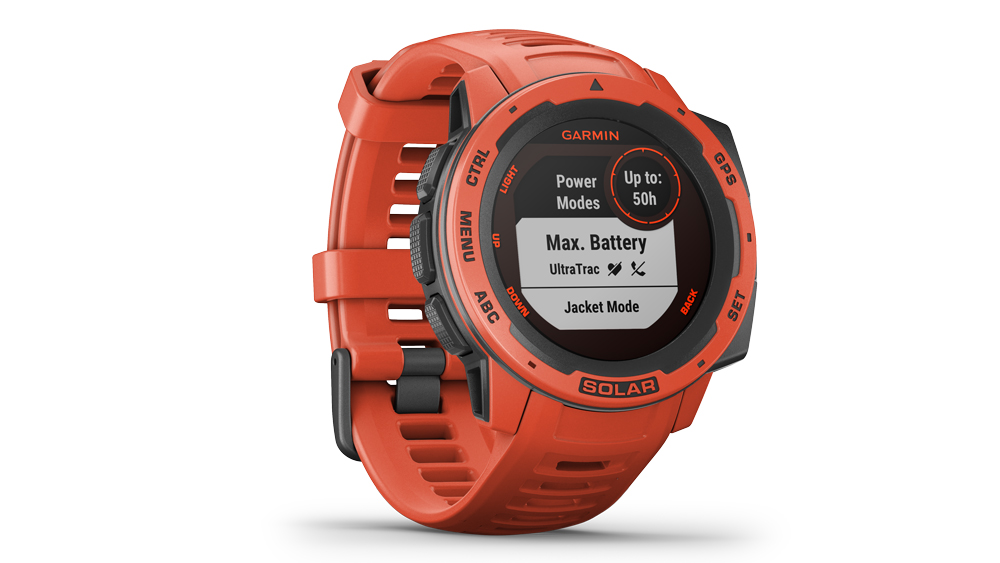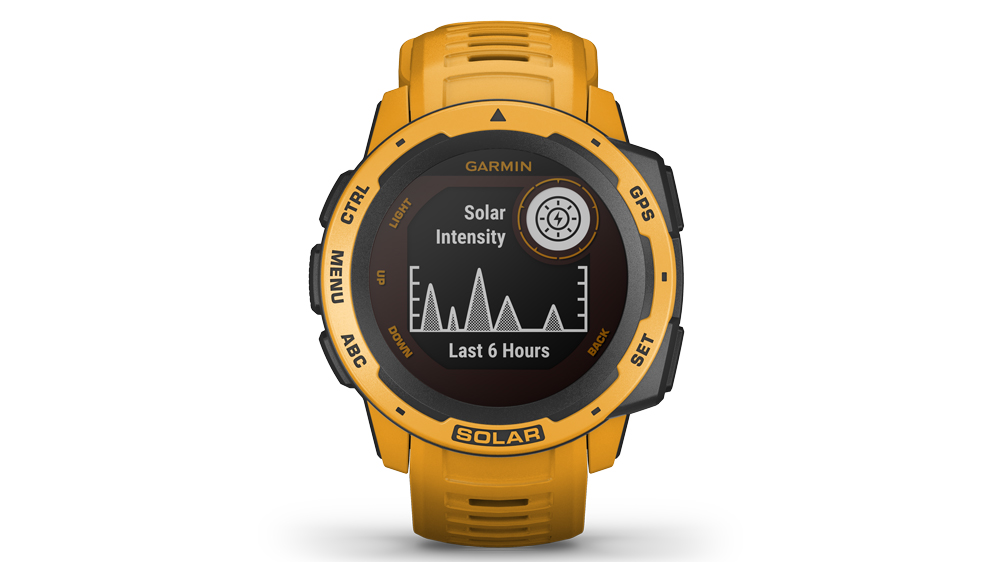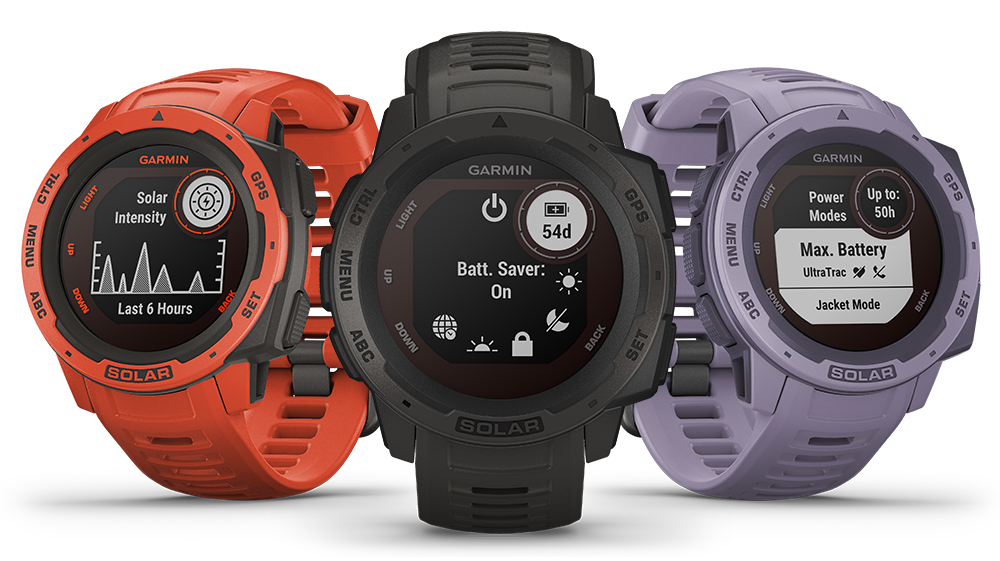Our Verdict
It can be easy to overlook the Instinct in Garmin’s range, with many drawn instead to the perennially popular Forerunner and Fenix lines, or the shiny smartwatch-style designs of the Vivoactive 4 or Venu. However, if you’re looking for a relatively cheap outdoor watch with a long battery life, solid sports tracking and navigation features, the Instinct is a sound option. The new solar edition of the watch is even more enticing because it offers the promise of increased battery life in sunny conditions, to the point where in Battery Saver mode it doesn’t need to be charged at all.
For
- The battery is second to none
- Excellent sports tracking
- Customisable workouts
- Can link to external sensors via ANT+ and Bluetooth
- Breadcrumb navigation
- Can create back-to-start routes
Against
- No training analysis features
- May look out of place in smarter settings
- Small screen
- Face dominated by solar panels
You can trust Coach
Buy from Garmin | From £349.99
Should I Consider Buying Something Else?
- Newsflash 9th February 2022: Garmin Instinct 2 launches
The Instinct Solar is a major upgrade on the Instinct, with new GPS and heart rate hardware along with the solar panels, with the result that the battery life takes a huge jump from 16 hours of GPS to 30 (38 with sufficient sun). There are also new features like expedition mode and a Pulse Ox sensor, so even though the standard Instinct is significantly cheaper at £269.99 it’s worth opting for the Solar.
That’s if you’re all about the great outdoors and like the Instinct design, however, because Garmin’s Forerunner watches provide very stiff competition to the Instinct Solar. The Forerunner 245 (£249.99, £299.99 with music) is the best-value running watch around, and a superb sports watch in general with more in-depth training analysis than the Instinct.
There is also Polar’s Grit X watch to consider. It’s £379 and although it doesn’t have solar panels and only lasts a week on a charge, it does offer 40 hours of GPS and has an ultramarathon mode to extend the battery to 100 hours. It’s better-looking than the Instinct too and has some clever features like FuelWise, which helps design a nutrition strategy for long exercise sessions.
It’s also worth saying that while the Instinct is a cheaper alternative to the Fenix 6 series, the Fenix watches are a significant cut above, with full-colour maps (on the Pro variants), plus in-depth training analysis, and smartwatch features like music and NFC payments. The price of the Fenix 6 Pro starts at £599.99, so it’s a lot more expensive, but if you’re looking for the best outdoor watch available that’s the one to buy.
See related
- Garmin Brings Solar Panels To The Fenix 6 And Instinct Watches
- Casio Pro-Trek WSD F30 Review: A Smartwatch For Outdoor Pursuits Falls Short
- How To Buy The Best Garmin Fitness Tracker For You
Garmin Instinct Solar In-Depth
Running With The Garmin Instinct Solar
While the Instinct might look different to Garmin’s Forerunner range, it comes equipped with most of the same top-drawer run-tracking features. You can set up your data screens with four stats on each, and use the GPS system, plus Galileo or GLONASS (the EU and Russian satellite systems, respectively), to ensure accurate distance tracking. On this front I found the Instinct Solar was always reliable, with no noticeable skews in the distance readings when under tree cover.
There is also a barometric altimeter in the watch, which improves the accuracy of tracking elevation changes, and it will give you the elevation plot of any routes you follow using the breadcrumb navigation.
The heart rate tracking during runs was also pretty close to the readings of a chest strap, though would lag behind during intervals, rising and falling a little slower than the chest strap. You can pair external monitors with the Instinct via ANT+ or Bluetooth if you’re looking for a reading that’s as accurate as possible.
However, you might not need better readings, because much of the benefit of having accurate HR readings is how that feeds into the training analysis available on other Garmin watches. This includes things like estimates of your VO2 max and race times, advice on how long your recovery should be after a run and an overall analysis of your training load to see if it’s proving productive or not. The Instinct Solar does not offer any of this, presumably because Garmin wants distinctive offerings, but it’s a shame that a £350 watch doesn’t offer features that the Forerunner 245 does for £100 less.
The screen is easy to read in all conditions while running, but it is smaller than on other watches, with much of the watch face taken up by the solar panels. This no doubt helps with battery life though, and if you prefer a larger, round screen then you are not short of options from Garmin.

You can set up a basic intervals mode on the watch to follow on a run, or create more complex structured workouts in Garmin Connect and sync them to the Instinct Solar. You can also follow breadcrumb routes on the watch, and if you get lost during a run you can get it to guide you back to where you started, either by showing you the direction of home as the crow flies or by following the route you came.
Like all Garmin sports watches, the Instinct Solar is an excellent option for runners, with accurate and comprehensive tracking. However, it is undermined by the lack of training analysis and the smaller screen makes it less enjoyable to use during a run than Forerunner watches like the 245, or even the more lifestyle-focused Vivoactive 4.
Battery Life On The Garmin Instinct Solar
Even before the solar boost is taken into account the Instinct Solar posts some very impressive numbers, offering 30 hours of GPS tracking and 24 days in watch mode. That compares with 16 hours of GPS and 14 days in watch mode on the original Instinct, with the increase probably down to the different GPS chipset in the Solar.

With enough sunlight those numbers climb to 38 hours of GPS and 54 days in watch mode, and you can also use a Battery Saver mode that turns off certain features to extend the battery life even further. Garmin says you can actually get unlimited battery life in Battery Saver mode with sufficient sunlight, though that claim is tricky to test. The power manager feature on the Fenix 6 series has been added to the watch to help you select which features you want on, and it also tells you how much extra battery you’ll get by turning off something like constant heart rate monitoring.
You can use the solar intensity widget to see how much sunlight the panels are being exposed to, and there are also watch faces that display this info as well. Fortunately for us Brits, it doesn’t have to be blazingly sunny out to charge the battery. I’ve found that the watch registers exposure to sunlight even on cloudy days.

It’s the increase in watch mode battery life that’s really telling on the Instinct Solar, because in between your activities it will barely drain at all, even with continual heart rate monitoring and notifications turned on. I found it lasted for ten days or so even when running almost every day and doing other sports like cycling, yoga and strength sessions. If you run outdoors a little less, it should go two to three weeks between charges.
It’s hard to know how much credit to give to the solar panels, simply because the Instinct Solar’s base battery life is so good anyway, but given how little the battery drains in watch mode you can see how a sunny hour or two could easily net you another day.
Activity Tracking With The Garmin Instinct Solar
While the Instinct Solar is primarily designed to be an outdoor sports watch, it does offer everyday activity tracking. Your steps, calories burned, active minutes and floors climbed are all recorded, and the daily step target can be set to automatically adjust to keep in line with your activity levels, so you always have an appropriate goal to shoot for.

The Instinct Solar also has Garmin’s Body Battery feature, which tracks your energy levels 24/7 and rates them out of 100, so you can get a quick snapshot of how much fuel you have in the tank depending on how well you’ve slept and the activity you’ve undertaken in the day.
Sports Tracking With The Garmin Instinct Solar
The Instinct Solar tracks a wide variety of sports, with several unique options aimed at outdoorsy types such as hunting and fishing where you can track your location using GPS and log your catches. You can track both indoor and open-water swimming with the watch, but there is no triathlon mode. This is still something Garmin reserves for high-end watches like the Forerunner 945 and the Fenix, which is a little frustrating when other brands have much cheaper watches that offer a full triathlon mode, like the Coros Pace 2.
There is also an expedition mode on the watch, which you can use to track multi-day activities. This mode turns off sensors like heart rate, and will take GPS readings of your position once an hour, both of which can extend the battery life to a huge 68 days if your expedition is taking place in sunny conditions.
Design And Build Of The Garmin Instinct Solar
The design of the Instinct Solar will probably appeal to its target audience, which is outdoorsy types who want a rugged device on their wrist. The chunky plastic look is also reminiscent of the G-Shock range, so if you like that style and want a more capable sports watch, the Instinct Solar is an attractive option.
However, the design will also put off many people, especially those used to the sleeker, more street-ready designs of Garmin’s Forerunner, Vivoactive or Fenix watches. I also found the bulky watch a little uncomfortable to wear at night when it was hot, though that’s rarely a major problem in the UK.

Nick Harris-Fry is a journalist who has been covering health and fitness since 2015. Nick is an avid runner, covering 70-110km a week, which gives him ample opportunity to test a wide range of running shoes and running gear. He is also the chief tester for fitness trackers and running watches, treadmills and exercise bikes, and workout headphones.

